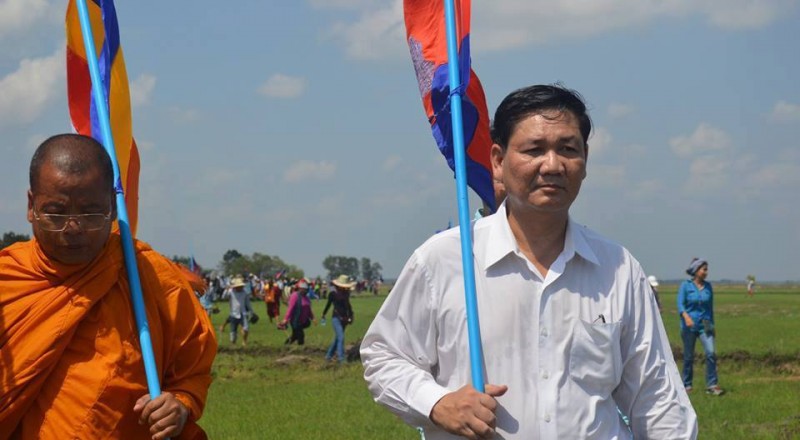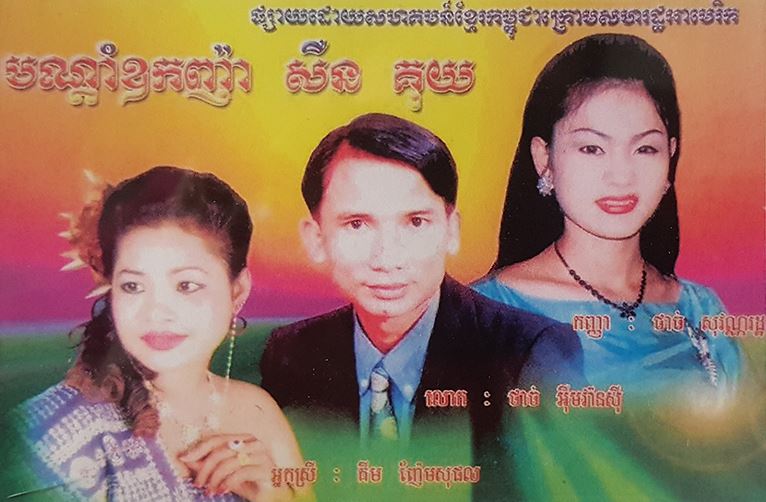គម្ពីរព្រះត្រៃបិដក ភាសាអង់គ្លេស The Tipitaka
Sat the 3rd Waning Moon of Kattikā B.E.2559, November 28, A.D.2015 Year of the Goat
Download The Tipitaka
Tripiṭaka
(Pali: Tipiṭaka) is a Sanskrit word meaning Three Baskets. It is the traditional term used by Buddhist traditions to describe their various canons of scriptures.[1] The Tripiṭaka traditionally contains three “baskets” of teachings: a Sūtra Piṭaka (Sanskrit; Pali: Sutta Pitaka), a Vinaya Piṭaka (Sanskrit and Pali) and an Abhidharma Piṭaka (Sanskrit; Pali: Abhidhamma Piṭaka).
The three categories
This section does not cite any references (sources). Please help improve this section by adding citations to reliable sources. Unsourced material may be challenged and removed. (September 2015)
Tripitaka comprises the three main categories of texts that is the Buddhist canon. The three parts of the Pāli canon are not as contemporary as the traditional Buddhist account seems to suggest: the Sūtra Piṭaka is older than the Vinaya Piṭaka, and the Abhidharma Piṭaka represents scholastic developments originated at least two centuries after the other two parts of the canon. The Vinaya Piṭaka appears to have grown gradually as a commentary and justification of the monastic code (Prātimokṣa), which presupposes a transition from a community of wandering mendicants (the Sūtra Piṭaka period ) to a more sedentary monastic community (the Vinaya Piṭaka period). Even within the Sūtra Piṭaka it is possible to detect older and later texts.
Vinaya
Rules and regulations of monastic life that range from dress code and dietary rules to prohibitions of certain personal conducts.
Mahayana sutras and Sutta Pitaka
The Buddha delivered all His sermons in local language of northern India. These sermons were collected during 1st assembly just after the death of the Buddha. Later these teachings were translated into Sanskrit.
Abhidharma
Philosophical and psychological discourse and interpretation of Buddhist doctrine. Written by Upagupta.
In Indian Buddhist schools
Each of the Early Buddhist Schools likely had their own recensions of the Tripiṭaka. According to some sources, there were some Indian schools of Buddhism that had five or seven piṭakas.
Mahāsāṃghika
The Mahāsāṃghika Vinaya was translated by Buddhabhadra and Faxian in 416 CE, and is preserved in Chinese translation (Taishō Tripiṭaka 1425).
The 6th century CE Indian monk Paramārtha wrote that 200 years after the parinirvāṇa of the Buddha, much of the Mahāsāṃghika school moved north of Rājagṛha, and were divided over whether the Mahāyāna sūtras should be incorporated formally into their Tripiṭaka. According to this account, they split into three groups based upon the relative manner and degree to which they accepted the authority of these Mahāyāna texts.[3] Paramārtha states that the Kukkuṭika sect did not accept the Mahāyāna sūtras as buddhavacana (“words of the Buddha”), while the Lokottaravāda sect and the Ekavyāvahārika sect did accept the Mahāyāna sūtras as buddhavacana.[4] Also in the 6th century CE, Avalokitavrata writes of the Mahāsāṃghikas using a “Great Āgama Piṭaka,” which is then associated with Mahāyāna sūtras such as the Prajñāparamitā and the Daśabhūmika Sūtra.
According to some sources, abhidharma was not accepted as canonical by the Mahāsāṃghika school.
The Theravādin Dīpavaṃsa, for example, records that the Mahāsāṃghikas had no abhidharma. However, other sources indicate that there were such collections of abhidharma, and the Chinese pilgrims Faxian and Xuanzang both mention Mahāsāṃghika abhidharma. On the basis of textual evidence as well as inscriptions at Nāgārjunakoṇḍā, Joseph Walser concludes that at least some Mahāsāṃghika sects probably had an abhidharma collection, and that it likely contained five or six books
Caitika
The Caitikas included a number of sub-sects including the Pūrvaśailas, Aparaśailas, Siddhārthikas, and Rājagirikas. In the 6th century CE, Avalokitavrata writes that Mahāyāna sūtras such as the Prajñāparamitā and others are chanted by the Aparaśailas and the Pūrvaśailas.[5] Also in the 6th century CE, Bhāvaviveka speaks of the Siddhārthikas using a Vidyādhāra Piṭaka, and the Pūrvaśailas and Aparaśailas both using a Bodhisattva Piṭaka, implying collections of Mahāyāna texts within these Caitika schools.
Bahuśrutīya
The Bahuśrutīya school is said to have included a Bodhisattva Piṭaka in their canon. The Satyasiddhi Śāstra, also called the Tattvasiddhi Śāstra, is an extant abhidharma from the Bahuśrutīya school. This abhidharma was translated into Chinese in sixteen fascicles (Taishō Tripiṭaka 1646).[9] Its authorship is attributed to Harivarman, a third-century monk from central India. Paramārtha cites this Bahuśrutīya abhidharma as containing a combination of Hīnayāna and Mahāyāna doctrines, and Joseph Walser agrees that this assessment is correct.
Prajñaptivāda
The Prajñaptivādins held that the Buddha’s teachings in the various piṭakas were nominal (Skt. prajñapti), conventional (Skt. saṃvṛti), and causal (Skt. hetuphala).[11] Therefore all teachings were viewed by the Prajñaptivādins as being of provisional importance, since they cannot contain the ultimate truth.[12] It has been observed that this view of the Buddha’s teachings is very close to the fully developed position of the Mahāyāna sūtras.
Sārvāstivāda
Scholars at present have “a nearly complete collection of sūtras from the Sarvāstivāda school”[13] thanks to a recent discovery in Afghanistan of roughly two-thirds of Dīrgha Āgama in Sanskrit. The Madhyama Āgama (Taishō Tripiṭaka 26) was translated by Gautama Saṃghadeva, and is available in Chinese. The Saṃyukta Āgama (Taishō Tripiṭaka 99) was translated by Guṇabhadra, also available in Chinese translation. The Sarvāstivāda is therefore the only early school besides the Theravada for which we have a roughly complete Sūtra Piṭaka. The Sārvāstivāda Vinaya Piṭaka is also extant in Chinese translation, as are the seven books of the Sarvāstivāda Abhidharma Piṭaka. There is also the encyclopedic Abhidharma Mahāvibhāṣa Śāstra (Taishō Tripiṭaka 1545), which was held as canonical by the Vaibhāṣika Sarvāstivādins of northwest India.
Mūlasārvāstivāda
Portions of the Mūlasārvāstivāda Tripiṭaka survive in Tibetan translation and Nepalese manuscripts. The relationship of the Mūlasārvāstivāda school to Sarvāstivāda school is indeterminate; their vinayas certainly differed but it is not clear that their Sūtra Piṭaka did. The Gilgit manuscripts may contain Āgamas from the Mūlasārvāstivāda school in Sanskrit.[15] The Mūlasārvāstivāda Vinaya Piṭaka survives in Tibetan translation and also in Chinese translation (Taishō Tripiṭaka 1442). The Gilgit manuscripts also contain vinaya texts from the Mūlasārvāstivāda school in Sanskrit.
Dharmaguptaka
A complete version of the Dīrgha Āgama (Taishō Tripiṭaka 1) of the Dharmaguptaka school was translated into Chinese by Buddhayaśas and Zhu Fonian (竺佛念) in the Later Qin dynasty, dated to 413 CE. It contains 30 sūtras in contrast to the 34 suttas of the Theravadin Dīgha Nikāya. A. K. Warder also associates the extant Ekottara Āgama (Taishō Tripiṭaka 125) with the Dharmaguptaka school, due to the number of rules for monastics, which corresponds to the Dharmaguptaka Vinaya.[16] The Dharmaguptaka Vinaya is also extant in Chinese translation (Taishō Tripiṭaka 1428), and Buddhist monastics in East Asia adhere to the Dharmaguptaka Vinaya.
The Dharmaguptaka Tripiṭaka is said to have contained a total of five piṭakas.[10] These included a Bodhisattva Piṭaka and a Mantra Piṭaka (Ch. 咒藏), also sometimes called a Dhāraṇī Piṭaka. According to the 5th century Dharmaguptaka monk Buddhayaśas, the translator of the Dharmaguptaka Vinaya into Chinese, the Dharmaguptaka school had assimilated the Mahāyāna Tripiṭaka (Ch. 大乘三藏).
Mahīśāsaka
The Mahīśāsaka Vinaya is preserved in Chinese translation (Taishō Tripiṭaka 1421), translated by Buddhajīva and Zhu Daosheng in 424 CE.
Kāśyapīya
Small portions of the Tipiṭaka of the Kāśyapīya school survive in Chinese translation. An incomplete Chinese translation of the Saṃyukta Āgama of the Kāśyapīya school by an unknown translator circa the Three Qin (三秦) period (352-431 CE) survives.
In the Theravada school
The complete Tripiṭaka set of the Theravāda school is written and preserved in Pali in the Pali Canon. Buddhists of the Theravāda school use the Pali variant Tipitaka to refer what is commonly known in English as the Pali Canon. Courtesy wikipedia
Related
សូមគាំទ្រឧបត្ថម្ភ សហគមន៍ខ្មែរក្រោម Support KKC
សូមអរគុណដ៏ជ្រាលជ្រៅចំពោះសប្បុរសជននូវវិភាគទានទាំងនេះ។
We’re On Facebook

Sign in
Click here to reload the page over ssl.





